Stonehenge was many things to many people and most of it has been already talked by others. It was a mausoleum with buried remains or urn containing the cremated ashes of their spiritual or patriarchal leaders. It was also a temple of worship of the Male and Female Principle as Shiv-Lingam and Yoni is to Hindus today. This has been discussed in previous posting and also suggested by others. The previous posting had a drawing which clearly shows the Lingam and Yoni aspect. (In other posting, I would show presence of Shiva in England and Greece). To the learned priest class, it was an observatory and a calender to observe, record and predict solar and lunar events, besides it being a place of worship and celebration. To many people of practical purpose, it was a place of social gathering and a place to do business. We would focus on Stonehenge being a calendering system.
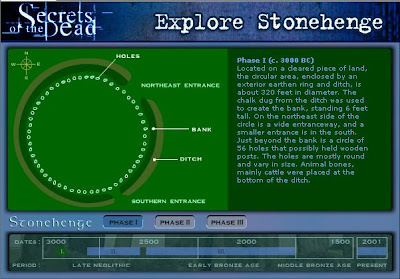
Phase 1 - Showing 56 Holes For Rotating Wooden Posts
56 holes for rotating the wooden posts in above picture shows that the ancients were tracking the 28 day lunar month. It is not clear why they would not cover the whole circle with 28 stones. Perhaps they were tracking the duration between odd full moons or even full moons for better accuracy, like one measures the wave length in a sine wave. Or they were trying to fit 360 solar days in a year with 6.5 turns instead of 13 turns for some reason - or 720 solar days with 13 turns of a 56 stone circle! This was their first attempt to make the calender and may have not been confident in tracking 28 days cycle only.
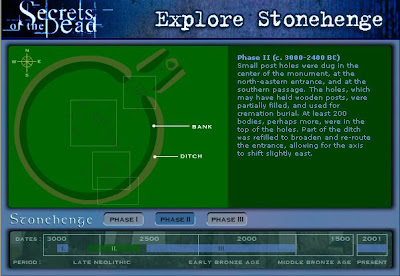
Phase 2 Showing Holes in North East and South East
Phase 2, the holes in center were perhaps to track the years but we would not be sure. And the holes in the north-east side were perhaps to track the Solar Solstices and the holes in the South East perhaps to track Solar Equinoxes. Their is some evidence of the Stonehenge tracking the same event in parallel to avoid mistakes arising because of some natural catastrophe or man made pranks by vandals.
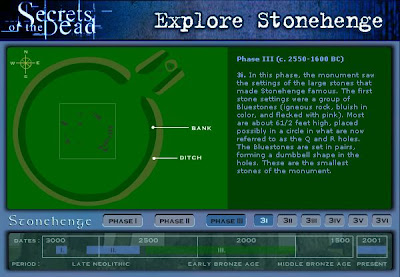
Phase 3 - 1 - Stone Henge
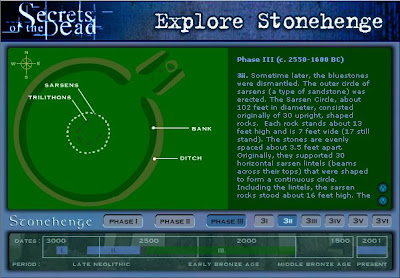
Phase 3-2. Shows 30 Vertical Stones and 30 Horizontal Stones in the Sarsen Circle
Perhaps all this time, the focus was on the size of the stones and how these stones were placed and how they were carried from far off places, that people did not see the connection between different circles.

Phase 3-3 - Stonehenge

Phase 3-4 Stonehenge
20 Stones, and as later we would see, they are placed in 19 + 1 pattern on each side of the semicircle, showing that 20 x 360 = 7200 Solar Days. 600 Years were being tracked, as 31 x 19 + 11 = 600. And 19 was being used to track the Metonic Cycle to predict the Lunar Eclipse. Later it would be shown that a cycle of 31, 30, 28, 24, 11, and 10 could be tracked, like a dial of a watch, besides the cycles of 1, 2, 19, and 20. All they had to do was to place different coded stones and rotate them.
Recall from previous postings that 600 Neros Cycle was being used and later they found that every 72 years the Sun would rise 1 degree off in Summer Solstice, accounting for the wobble of the earth's axis, with the cycle of 25920 years! More on this later.
This knowledge, though shown to be known to all Proto Indo Europeans all over the world in forms of stories in their mythology, was lost by the ancients except for Hindus till date, perhaps showing the most "orthodox" and "staunch" believers of the religion from the ancient times, which is kind of backed by the observation that Hinduism is the last vestige of the Prototype Indo European Religion. Babylonians and Persians knew this, and Egyptians and Greeks had copied this concept, but without keeping up with the Hindus, who kept refining this. Before they settled at 72 years to 1 degree relationship, they would go as far as 100 years and as low as 60 years to 1 degree relationship. I am thinking just a brief on the whole article, as I have realized now that people may not have time to read and patience to digest all the boring details.
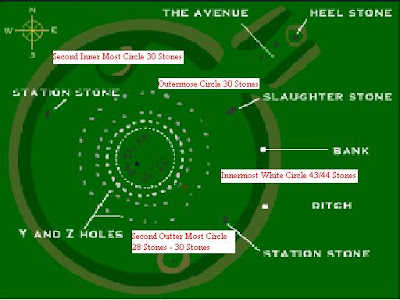
Inner Circle - Stonehenge
The above picture shows that the X and Z holes had 30 stones and 30/28 stones respectively. In another book they have talked about one of the circles having 31 stones. The third inner circle showing 30 stones and the innermost circle having 43 or 44 stones. The multiple 30 stones perhaps indicates tracking solar days in multiple, and/or tracking other larger numbers with factors of 30. If we account for 28 stones in one of the circle, it would be tracking lunar days and month, which makes sense, if one has to account for 2 circles for lunar months (including the outer circle that had 56 stones) and 2 circles for solar months. We are still left with inner most circle of 30 stones and 43/44 stones. Recall we had 20 stones covered in horse show ring, which makes 20 x 30 = 600. It is not clear why we have 43 or 44 stones or if that numbering is correct. There is a wobble of another kind, called "Chandler Wobble", which was discovered recently, and it has a period of 433 days. Since 10 and 5 were encoded in the horse-shoe circle, is it possible to code this as 10 x 43 + 3 ? Interesting, we have shown 4320 was an interesting number to the ancients. So was 43 and 20 being encoded somehow? Also, 19 x 31 + 11 = 600, so 4 x (19 x 31 + 11) = 4 x 19 x 31 + 44 = 2400, which was another cycle of importance, and we shall see that 24 was also encoded in another circle!
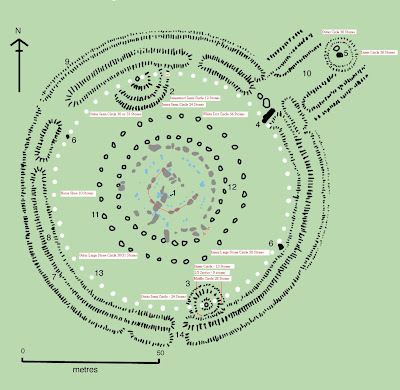
Inner Circle - Stone henge with North-West and South-East Semi/Full Circles (double-click to magnify)
The South East Circles shows 28 stones in Middle Circle , 13 stones in Inner Circle, and 24 stones in Outer circle. 28 x 13 = 364, which is what the later years started looking like, and 24 x 30 = 720. This shows later efforts to reconcile the lunar calender with the solar calender and also account for increase in duration in Solar Years from 360 to 364, 365 and 366 days. Please note, that some "stones" have been counted by extrapolating equidistant points or counting stones in one 1/3 sector. Needless to say, 7200 = 24 x 30 x 10, which was show before as 360 x 20.
The North West Semicircles shows Outer most semicircles with 31/30 and 30 stones, and inner most semicircle with 24 and 12 stones. The use of 24 perhaps backs the observation that the duration between odd or even years was also being tracked for accuracy reasons.
The fact these circles and semi-circles are smaller, showing they were installed later, and somehow being squeezed into a tight space, shows an adapting architecture in Stonehenge as the ancients' knowledge on different astronomical cycles increased and as they shifted from a Lunar Calender to a Solar Calendar.
The NW alley circles, marked 5, has 36 stones each. Knowing that they had stone circles to count factors of 20, 10, 2, it is easy to visualize, they counting cycles 720, 360 and 72! 25920 cycle comes to 36 x 36 x 2 x 10. What this means is that could project cycles of 25920 precession, based on observation of shifting zodiacs associated with the solstices, which they settled down to 1 degree for every 72 years!


The above two pictures, confirm the star was the symbol of Male and Female Principle, which was worshiped by Hindus and Stonehenge alike. The triangle pointing upwards was the Male Principle and the triangle pointing downwards was the Female Principle. Also, most of the stone circles are marked with 2 stones or alleys to mark the passage between the womb, denoted by the circle, and the outer world, to worship the Female Principle.

The picture confirm that that the inner horse-shoe had 19 stones, and the outer horse ring had 10 stones, and the next inner circle had 40 stones, but it pattern of 19 + 1 + 1 + 19. The outer inner circle is confirmed to have 30 stones.
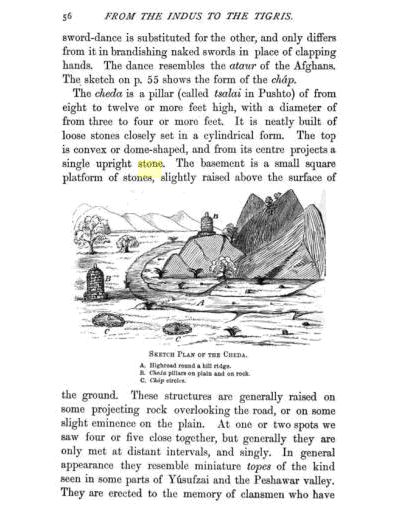
Stonecircles with the Male Principle and the Female Principle Worship found in Afganistan area.
So even, we do not have a complete accurate knowledge of stones in the all circles, in Stonehenge as well in other stone circles from Europe and India, some of the numbers which are needed in the astrology and astronomical observations, do constantly resurface everywhere. And knowing that we inherited these magic numbers from our distant ancients, and did not invent them, it is quite likely that the ancients were lot smarter than we have acknowledged, and their knowledge of mathematics and astronomy was far ahead than it has been acknowledged.
I will conclude the article by borrowing the article from Godfrey Higgins's Anacalypsis, page 313.
THE STONE CIRCLES OF INDIA.
Here I think the temenos was the Gilgal of Dr. Clarke. See CELTIC DRUDS, passim. And from this we may not unreasonably suspect that the re/xei/os meant a stone circle : or, at all events, that a stone circle was a Te/ievos.
In my Celtic Druids I have given an example of two Cromlehs in India, plates 39 and 40, and I have given a drawing of another in figure 18 of this work. I have since found that stone circles, similar to our Stonehenge, Abury, &c., are very common in the northern parts of India. The natives can give no account of them.
These circles appear to be a remnant of antiquity of a similar species to those of the Puniha-Pandawars, a great number of which are to be seen scattered on the adjacent heights about a mile west of a place called Durnacotta. The stones composing these circles are of a hard blackish granite, very irregular in shape, measuring in general about three feet in height, and of the same dimension in thickness. The country people seem ignorant on the subject of these antiquities, and can give no information for what purposes they were designed. It is reported that circles of a similar description are very numerous among the skirts of the hills of Wudlamaun and others in that neighbourhood, that on some of these being opened by the late Rajah, Vassareddy, they were found to contain human bones of a large size, and that in some there were earthen pots curiously placed together containing ashes or charcoal. Similar to the above at Amravutty, on the river Christna or Kistna, is to be seen a mound called Depaldenna.(Note 1)
Drawings of great numbers of these circles may be seen in Mackenzie's manuscripts above-mentioned. I shall give a drawing of only one of them, because, although there is no reason to doubt the general accuracy of the accounts, yet no attempt has been made to ascertain of what numbers of stones these circles originally consisted, which was the only thing that could render them really useful; but which, as was originally the case in England, was thought to be of no consequence. It is, however, remarkable that, in the circle which I have given, fig. u, as the reader will find on counting them (allowance being made for one evidently broken), 19 stones, the number of the Metonic cycle, are found.
Note 1: See Col.Mackenzie's manuscripts, India Antiqua Illustrata, in the musuem in India-House, No 9, 1816-1817, and my plates Fig. 11.
